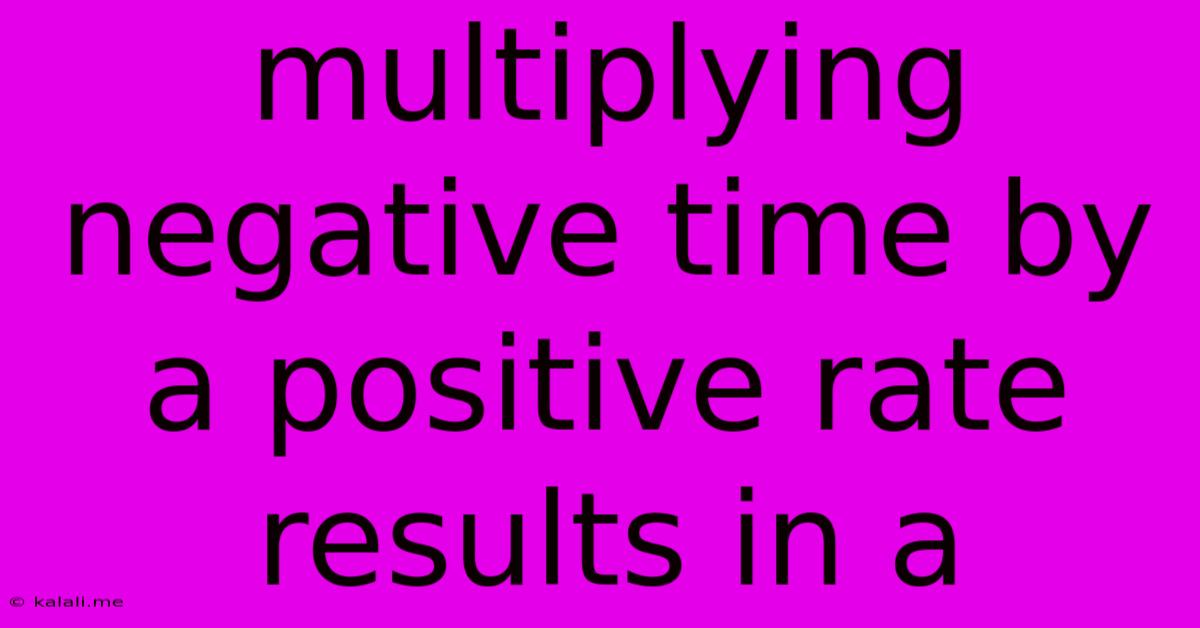Multiplying Negative Time By A Positive Rate Results In A
Kalali
May 24, 2025 · 3 min read

Table of Contents
Multiplying Negative Time by a Positive Rate: Understanding the Result
This article explores the concept of multiplying negative time by a positive rate, a scenario that often arises in various fields, including finance, physics, and project management. We'll delve into the mathematical implications and provide practical examples to illustrate the meaning and interpretation of the result. Understanding this concept is crucial for accurate calculations and proper interpretation of data.
What does "negative time" represent?
Before we dive into multiplication, let's clarify what negative time signifies. Negative time doesn't represent time traveling backward. Instead, it usually indicates a time relative to a specific reference point. For instance:
- In finance: Negative time could represent past due dates or periods before a specific investment. A negative time value of -3 days would mean 3 days before the reference date.
- In project management: Negative time could represent delays or setbacks. A negative time value of -2 weeks signifies a project is 2 weeks behind schedule.
- In physics: Negative time can be used within specific contexts, such as representing time before an event, particularly in relativistic physics.
Multiplying Negative Time by a Positive Rate:
When you multiply a negative time value by a positive rate, the result remains negative. This is because the multiplication simply scales the magnitude of the negative time value. The positive rate acts as a scaling factor, stretching or compressing the time duration, while preserving the negative sign.
Let's illustrate this with examples:
-
Example 1 (Finance): You have a debt that is -5 days overdue, and the daily interest rate is 0.05. The total accumulated interest would be (-5 days) * (0.05/day) = -0.25. The negative value indicates that you have accrued -0.25 units of interest which is equivalent to a reduction of interest charges.
-
Example 2 (Project Management): A project is -3 weeks behind schedule, and each week incurs a penalty of $1000. The total penalty would be (-3 weeks) * ($1000/week) = -$3000. The negative sign indicates a negative financial impact or a cost that has already been incurred and is not recovered.
-
Example 3 (Simple Physics): Imagine an object moving backward at -5 m/s for 2 seconds. Calculating the distance covered, we have (-5 m/s) * (2 s) = -10m. The negative sign shows the object moved 10 meters in the negative direction (backward).
Interpreting the Result:
The key takeaway is to understand the context and carefully interpret the negative sign in the result. It doesn't always mean a "negative" outcome in a bad sense. The sign simply indicates the direction or significance relative to the reference point.
In Conclusion:
Multiplying a negative time value by a positive rate will always yield a negative result. The significance of this negative result depends entirely on the context in which the calculation is performed. Accurate interpretation relies on understanding the meaning of negative time within that specific context, as well as the implications of a negative final value. Always consider the units of measurement to ensure consistent and meaningful calculations.
Latest Posts
Latest Posts
-
Why Harry Doesnt Know That Norman Is Green Goblin
May 24, 2025
-
How To Get Rid Of Musty Smell In Basement
May 24, 2025
-
How To Get Rust Off Clothes
May 24, 2025
-
Wire Size For 40 Amp Breaker
May 24, 2025
-
Wand Of The War Mage 5e
May 24, 2025
Related Post
Thank you for visiting our website which covers about Multiplying Negative Time By A Positive Rate Results In A . We hope the information provided has been useful to you. Feel free to contact us if you have any questions or need further assistance. See you next time and don't miss to bookmark.